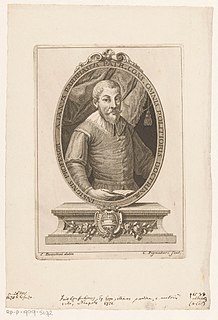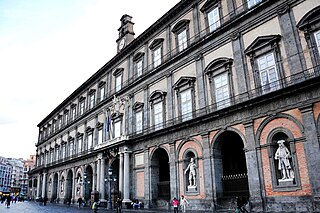
The House of Savoy was a royal dynasty that was established in 1003 in the historical Savoy region. Through gradual expansion, the family grew in power from ruling a small Alpine county north-west of Italy to absolute rule of the Kingdom of Sicily from 1713 to 1720, when they were handed the island of Sardinia, over which they would exercise direct rule from then onward.

Prince Vittorio Emanuele of Savoy, Prince of Naples is the only son of Umberto II, the last King of Italy, and his wife Marie-José of Belgium. Vittorio Emanuele also uses the title Duke of Savoy and claims the headship of the House of Savoy. These claims were disputed by supporters of his third cousin, Prince Aimone, 6th Duke of Aosta.

The Vergilius Romanus, also known as the Roman Vergil, is a 5th-century illustrated manuscript of the works of Virgil. It contains the Aeneid, the Georgics, and some of the Eclogues. It is one of the oldest and most important Vergilian manuscripts. It is 332 by 323 mm with 309 vellum folios. It was written in rustic capitals with 18 lines per page.

Jørgen Zoëga was a Danish scientist. He was noted for his work as an archaeologist, numismatist and anthropologist.

Prince Amedeo of Savoy-Aosta, 5th Duke of Aosta was a claimant to the headship of the House of Savoy, the family which ruled Italy from 1861 to 1946. Until 7 July 2006, Amedeo was styled Duke of Aosta; on that date he declared himself Duke of Savoy, a title that was disputed between him and his third cousin, Vittorio Emanuele, Prince of Naples, only son of King Umberto II of Italy.

Abraham Cresques, whose real name was Cresques (son of) Abraham, was a 14th-century Jewish cartographer from Palma, Majorca. In collaboration with his son, Jehuda Cresques, Cresques is credited with the authorship of the celebrated Catalan Atlas of 1375.

Giovan Paolo Parisio (1470–1522), who used the classicised pseudonym Aulo Giano Parrasio or Aulus Janus Parrhasius, was a humanist scholar and grammarian from Cosenza, in Calabria in southern Italy. He was thus sometimes known as "Cosentius". He was a member of the Accademia Pontaniana of Naples, and founded the Accademia Cosentina, an accademia or learned society in Cosenza, in 1511–12.

The Royal Palace of Naples is a palace, museum, and historical tourist destination located in central Naples, southern Italy.

The Coptic White Monastery, also The Monastery of Abba Shenouda and The Athribian Monastery is a Coptic Orthodox monastery named after Saint Shenouda the Archimandrite. It is located near the Upper Egyptian cities of Tahta and Sohag, and about two and a half miles (4.0 km) south-east of the Red Monastery. The name of the monastery is derived from the colour of the white limestone of its outside walls. The White Monastery is architecturally similar to the Red Monastery.

There have been many Coptic versions of the Bible, including some of the earliest translations into any language. Several different versions were made in the ancient world, with different editions of the Old and New Testament in five of the dialects of Coptic: Bohairic (northern), Fayyumic, Sahidic (southern), Akhmimic and Mesokemic (middle). Biblical books were translated from the Alexandrian Greek version.

Stefano Borgia was an Italian Cardinal, theologian, antiquarian, and historian.

The Biblioteca nazionale Vittorio Emanuele III is a national library of Italy. It occupies the eastern wing of the 18th-century Palazzo Reale in Naples, at 1 Piazza del Plebiscito, and has entrances from piazza Trieste e Trento. It is funded and organised by the Direzione Generale per i Beni Librari and the Ministero per i Beni e le Attività Culturali.
Minuscule 108 (in the Gregory-Aland numbering), A144 (Soden), is a Greek minuscule manuscript of the New Testament, on parchment leaves. Paleographically it has been assigned to the 11th century. It has complex contents with some marginalia.
Minuscule 401, ε 236, is a Greek minuscule manuscript of the New Testament, on parchment. Palaeographically it has been assigned to the 12th century. It has marginalia.
Minuscule 402, ε 428, is a Greek minuscule manuscript of the New Testament, on parchment. Palaeographically it has been assigned to the 14th century. It has marginalia.
Lectionary 46, designated by sigla ℓ46, is a Greek manuscript of the New Testament, on purple parchment leaves. Palaeographically, it has been assigned to the 9th century. It was formerly known as Codex Vindobonensis 2.
Lectionary 138, designated by siglum ℓ138 is a Greek manuscript of the New Testament, on paper leaves. Palaeographically it has been assigned to the 15th century.
Minuscule 843, ε237, is a 12th-century Greek minuscule manuscript of the New Testament on parchment. The manuscript is lacunose.

The Codex Aesinas is a 15th-century composite manuscript. It was discovered by chance in 1902 at the former private estate of the Count Baldeschi Balleani family located in Jesi, in the province of Ancona, Italy. The manuscript is considered especially valuable because it contains the Opera Minora of the Roman historian Tacitus, including the Agricola and the Germania. Due to the inclusion of eight folia written in Carolingian minuscule script within the Agricola, the Tacitus portion of the Codex is generally regarded as a direct copy of the missing Codex Hersfeldensis (H), a 9th-century manuscript that contained a copy of the original Opera Minora by Tacitus. The Carolingian folia are thought to be originals taken from the lost codex. In 1994, the Baldeschi Balleani family sold the codex to the Biblioteca Nazionale Centrale di Roma where it is now known as the Codex Vittorio Emanuele 1631.













